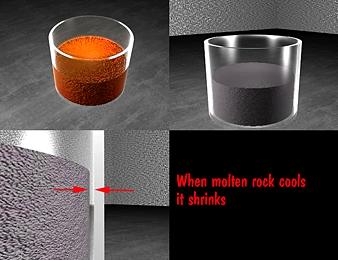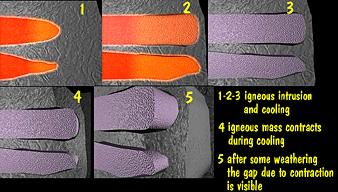One could reasonably ask the question, what makes the original cracks in the rock for the water to attack? There are several answers but one of the most important is the rock cooling process from a melt.
We have discussed the fact that a cooling magma can fractionally crystallize depositing materials and changing the composition of the magma as it cools. Because rocks are not homogenous, the individual minerals that form them have different thermal expansion and contraction coefficients.
(Thermal expansion and contraction coefficients: relate to the amount a rock increases in size when heated and how much it decreases in size when cooled. -- Remember it is a rate of expansion and cooling.)

A mixed material (rock: a mixture of minerals) can be rapidly heated and then quickly cooled, and it may provide enough force for the individual parts to separate at their boundaries. This makes small fractures at the individual grain boundaries that are large enough for liquid water to penetrate.
When a magma cools (unlike water) its over all volume contracts, it pulls away from the surrounding rock causing a void space. This may be readily visible with the naked eye, or may be only microscopically visible depending on the chemistry of the magma.
Since the chemistry of the magma may be changing as fractional crystallization occurs, the contraction may vary along the intrusive body.

In the first example we see a beaker of magma solidify and it decreases in volume and pulls away form the container sides. In thermal world the magma first moves along small joints in the surrounding (country rock), and expands driven by pressure from behind or within. Remember that hotter magma rises because it is less dense or can be forced forward by dissolved gases or water.
Magma intrusions eventually reach the end of their expansion stage, and begin to cool. As they cool they contract from their surrounding country rock. Water draining from the surface, or water entering the cracks around the intrusive body from country rock create a ready path for weathering.
| NEXT | TOC | PREV |